Search
- Page Path
- HOME > Search
Research Articles
- [English]
- Sex differences in the association between Korean Healthy Eating Index and type 2 diabetes mellitus in Korean adults: a prospective cohort study
- Yeeun Park, Minji Kim, Kyong Park
- Korean J Community Nutr 2025;30(5):331-340. Published online October 31, 2025
- DOI: https://doi.org/10.5720/kjcn.2025.00227

-
 Abstract
Abstract
 PDF
PDF Supplementary Material
Supplementary Material - Objectives
Dietary quality is a modifiable determinant of type 2 diabetes mellitus (T2DM). However, evidence on the Korean Healthy Eating Index (KHEI) and sex-specific differences in its association with T2DM risk remains limited. This study is to examine the longitudinal association between KHEI and incident T2DM in Korean adults, with a focus on potential sex differences.
Methods
We analyzed 56,000 adults (37,684 women and 18,316 men) from the Health Examinee cohort of the Korean Genome and Epidemiology Study. Dietary intake was assessed using a validated semi-quantitative food frequency questionnaire, and KHEI scores were constructed based on national guidelines. Incident T2DM was defined using physician diagnosis, treatment history, or biochemical criteria. Cox proportional hazards models and restricted cubic spline analyses were applied to evaluate associations, with adjustments for demographic, lifestyle, and clinical covariates.
Results
Over a median follow-up of 4.2 years, 2,252 women and 1,776 men developed T2DM. Women in the highest quartile of KHEI had a 18% lower risk of T2DM compared with those in the lowest quartile (hazard ratio [HR]: 0.82, 95% confidence interval [CI]: 0.71–0.93; P for trend = 0.007). In men, no significant association was observed (HR: 1.11, 95% CI: 0.95–1.29). The interaction by sex was statistically significant (P for interaction < 0.05). Spline analyses indicated a linear inverse association between KHEI and T2DM risk in women, whereas no trend was evident in men.
Conclusion
Higher diet quality, as measured by the KHEI, was associated with a reduced risk of T2DM in women but not in men, suggesting sex-specific effects of dietary patterns on diabetes prevention. These findings highlight the need for tailored nutritional strategies that consider biological and behavioral differences between women and men in Korea.
- 257 View
- 10 Download

- [English]
- Comparison of clinical characteristics and dietary intakes according to phenotypes of type 2 diabetes mellitus in South Korea: a cross-sectional study
- Mi-Jin Kim, Ji-Sook Park, Sung-Rae Cho, Daeung Yu, Jung-Eun Yim
- Korean J Community Nutr 2025;30(2):127-139. Published online April 29, 2025
- DOI: https://doi.org/10.5720/kjcn.2025.00059
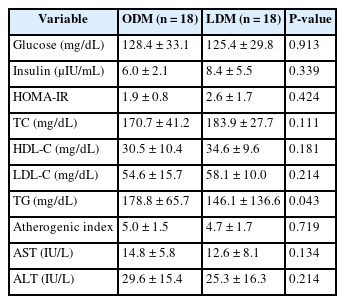
-
 Abstract
Abstract
 PDF
PDF - Objectives
Clinical nutrition treatment is the central part of diabetes management, such as prevention, treatment, and self-management of diabetes, and personalized clinical nutrition treatment, which enables improvement in patients with type 2 diabetes mellitus (T2DM). Our study aimed to contribute to the improvement of appropriate nutrition management in personalized treatment for obese and non-obese diabetes patients.
Methods
T2DM patients were recruited as participants, and 36 final participants were assigned to the lean diabetes mellitus group (LDM; body mass index [BMI] < 25 kg/m2) and the obese diabetes mellitus group (ODM; BMI ≥ 25 kg/m2). We assessed the dietary intakes, body composition, dietary habits, the Korean version of obesity-related quality of life, and biochemical indices.
Results
According to the phenotype’s comparison, the ODM group had a high prevalence of T2DM complications and hypertension, had a dietary habit of less than 10 minutes of mealtime duration and preferred fast food intake, and had a low obesity-related quality of life. However, the LDM group had a high choice of Korean dishes at the time of eating out and a high intake of vitamin C, and iodine because of the intake of vegetables and seaweeds.
Conclusion
We observed differences in diet, nutrient intake, and clinical characteristics according to the phenotype of T2DM patients. In particular, obese diabetes patients have an increased risk of cardiovascular diseases, bad dietary habits, and low obesity-related quality of life. Therefore, personalized nutrition treatment is needed in consideration of the risk of cardiovascular disease and dietary habits for patients in the ODM group, as well as determining the energy requirements of Korean patients with T2DM.
- 1,362 View
- 31 Download

- [English]
- Effects of a multi-component program based on partially hydrolyzed guar gum (Sunfiber®) on glycemic control in South Korea: a single-arm, pre-post comparison pilot clinical trial
- Hyoung Su Park, A-Hyun Jeong, Hyejung Hong, Hana Jang, Hye-Jin Kim
- Korean J Community Nutr 2025;30(1):40-52. Published online February 28, 2025
- DOI: https://doi.org/10.5720/kjcn.2024.00276
- Correction in: Korean J Community Nutr 2025;30(2):173

-
 Abstract
Abstract
 PDF
PDF - Objectives
The aim of this study was to assess the impact of a multi-component program, including partially hydrolyzed guar gum (PHGG, Sunfiber®) supplementation, on glycemic control, gut health, and nutritional status to support diabetes prevention and management among Korean adults.
Methods
A single-arm trial was conducted with 29 adults (aged 20-55 years) with fasting plasma glucose (FPG) ≥ 100 mg/dL. Over a six-week period, participants engaged in a multi-component program that incorporated the supplementation of PHGG (Sunfiber®, 12.5 g/day), weekly nutritional coaching, and the use of continuous glucose monitoring devices. The program’s effectiveness was evaluated by measuring FPG and glycated hemoglobin (HbA1c) levels through blood tests conducted before and after the intervention. Improvements in gut health were gauged using the Korean Gut Quotient Measurement Scales, while enhancements in nutritional status were assessed using the Nutrition Quotient (NQ) and surveys that evaluated improvements in gut health and nutritional status.
Results
Participants’ average age was 43.89 years, with approximately 80% being male. Most participants (about 75%) were classified as overweight or obese. After six-weeks, 17 participants who adhered closely to the program (meeting certification criteria) exhibited significant reductions in key blood glucose markers. FPG levels decreased from 113.06 ± 23.16 mg/dL to 106.24 ± 16.33 mg/dL (P < 0.05), and HbA1c levels decreased from 6.08% ± 0.81% to 5.87% ± 0.53% (P < 0.05). The NQ evaluation revealed significant increases in comprehensive nutrition scores, and in the balance and practice domain scores for all participants (P < 0.05). Furthermore, in the gut health survey, approximately 82.1% of all participants reported experiencing positive changes.
Conclusion
Among adults with elevated FPG levels, a multi-component intervention program that included PHGG (Sunfiber®) supplementation, structured dietary management, and the use of health-monitoring devices showed significant benefits in improving glycemic control, overall nutritional status, and gut health. Trial Registration: Clinical Research Information Service Identifier: KCT0010049.
- 6,195 View
- 41 Download

- [Korean]
- Biochemical characteristics, nutrient intakes, and chronic disease risk according to the dietary fat energy ratio in middle-aged Korean: a cross-sectional study using data from the 7th (2016–2018) Korean National Health and Nutrition Examination Survey
- Ga-Hyeon Jeong, Sook-Bae Kim
- Korean J Community Nutr 2024;29(6):528-540. Published online December 31, 2024
- DOI: https://doi.org/10.5720/kjcn.2024.00304
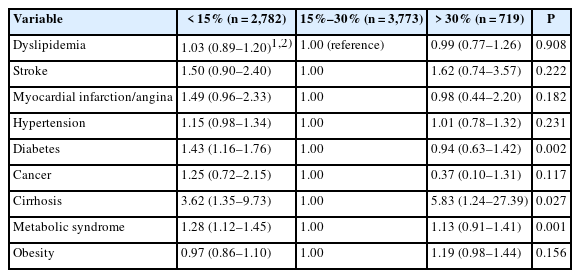
-
 Abstract
Abstract
 PDF
PDF - Objectives
This study aimed to examine health-related characteristics and chronic disease risk in middle-aged Koreans based on their fat energy intake ratio.
Methods
We analyzed data from 7,274 Koreans aged 40–64 years using the 7th (2016–2018) Koreans National Health and Nutrition Examination Survey. Participants were classified into three groups based on their fat energy intake ratio: insufficient (< 15%), adequate (15%–30%), and excessive (> 30%). We assessed their socio-demographic characteristics; lifestyle characteristics; biochemical characteristics; quantitative and qualitative nutrient intakes, measured using dietary reference intakes for Koreans and index of nutrition quality (INQ); and chronic disease risk.
Results
Significant differences were observed between the groups in age, gender, income, education, and residence region. The insufficient group had the highest proportion of older adults, male, lower income, rural residents, and lower education levels. The groups differed significantly in lifestyle characteristics, with the insufficient group having the highest rates of no walking, heavy drinking, smoking, and poor subjective health perception. Biochemical characteristics in the insufficient group exhibited the lowest levels for fasting blood glucose, hemoglobin A1c, and triglycerides. Significant differences were found in both the quantitative and qualitative intake of nutrients. The insufficient group had the lowest intake of most nutrients except fiber, whereas the excessive group had the lowest fiber intake. Based on the INQ, vitamin A and Ca were the lowest in the insufficient group, and vitamin C and folic acid were the lowest in the excessive group. The risk of diabetes mellitus and metabolic syndrome was highest in the deficient group, and the risk of liver cirrhosis was highest in the excessive group.
Conclusion
Insufficient or excessive fat energy intake ratio negatively affects nutrient intake and chronic disease risk. Fat energy intake of 15%–30% is important for improving nutrient intake and managing chronic diseases, such as diabetes mellitus, metabolic syndrome, and liver cirrhosis. We suggest that education and an appropriate social environment are necessary to ensure this fat energy intake. -
Citations
Citations to this article as recorded by- Study on the Optimization of Manufacturing Conditions for Traditional Potato Bugak Using Response Surface Methodology
Yu Hyeon Jo, Jeong Ok Rho
Journal of the East Asian Society of Dietary Life.2025; 35(1): 60. CrossRef - Nutritional risk assessment using estimated usual nutrient intake in Korean adults: analysis of the 8th (2019–2021) Korea National Health and Nutrition Examination Survey data
Woojin Byeon, Cho-il Kim, Sung Ok Kwon, Jihyun Yoon, Linxi Huang
Nutrition Research and Practice.2025; 19(5): 799. CrossRef
- Study on the Optimization of Manufacturing Conditions for Traditional Potato Bugak Using Response Surface Methodology
- 1,236 View
- 45 Download
- 2 Crossref

- [Korean]
- Impact of a public health center nutrition education program on patients with type 2 diabetes in a primary care-based chronic disease management project: a pilot intervention study
- Haerim Yang, Yoo Kyoung Park, Ji-hyun Lee, Hee-Sook Lim, Heejoon Baek, Hyejin Lee, Haeran Park, Pyunghwa Lee, Jooyoun Chung, Won Gyoung Kim
- Korean J Community Nutr 2024;29(6):492-503. Published online December 31, 2024
- DOI: https://doi.org/10.5720/kjcn.2024.00018
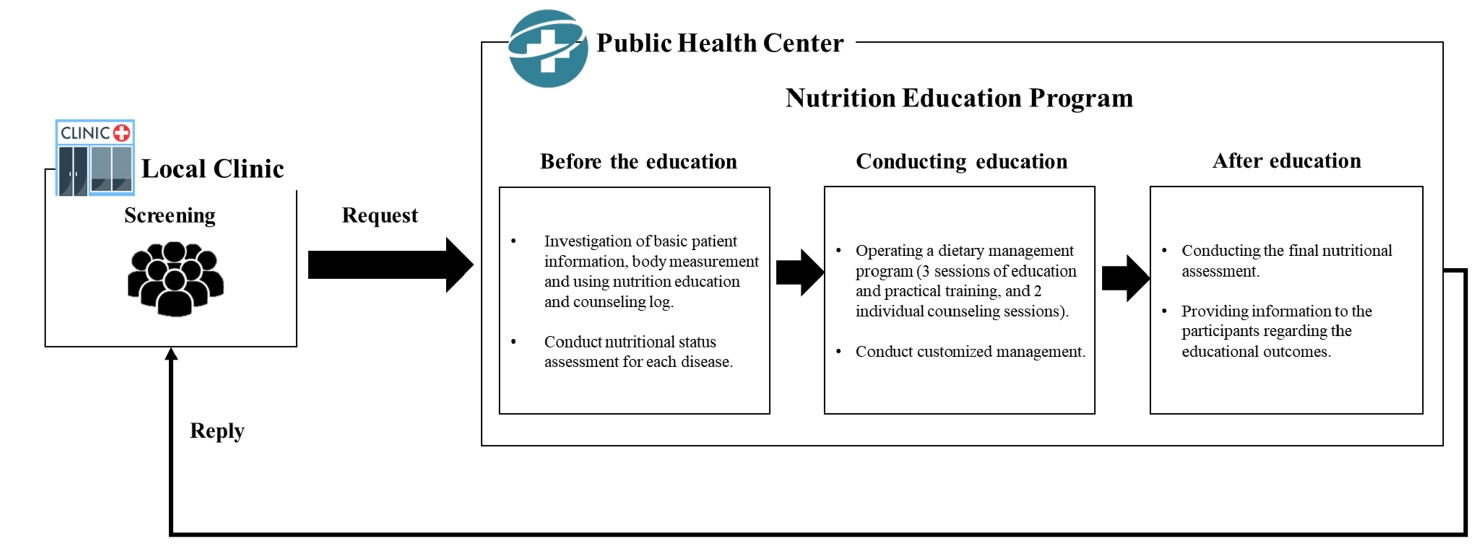
-
 Abstract
Abstract
 PDF
PDF - Objectives
We investigated the impact of an advanced “Nutrition Education Program” on patients with Diabetes mellitus, type 2 from public health centers enrolled in a primary health care-based chronic disease management project. This 12-week dietary management program was developed by the Korea Health Promotion and Development Institute. We assessed if this program improved glycemic control and other health indicators through dietary and nutritional improvements.
Methods
Seventeen patients with Diabetes mellitus type 2 were enrolled in the “Nutrition Education Program.” These patients were referred to public health centers for lifestyle management based on physician assessments at local clinics that were participating in a pilot project on primary health care-based chronic disease management. The participants attended the program comprising face-to-face basic, in-depth, and practical training sessions at the health center during the third, fifth, and seventh weeks, respectively. Anthropometric measurements, body composition analysis, blood biochemical characteristics, nutritional knowledge, and self-efficacy evaluation were performed before and after the program. Data were analyzed using SPSS ver. 28.0.
Results
The mean age of the participants was 62 years, and most participants were female (14, 82.4%). No significant changes in patients’ anthropometric measurements or body composition were observed after the training. However, significant reductions were observed in the blood biochemical characteristics, including glycated hemoglobin, total cholesterol, and low-density lipoprotein levels. Additionally, patients’ nutritional knowledge and self-efficacy scores increased significantly.
Conclusions
The “Nutrition Education Program” helped in improving glycemic control and other health indicators in patients with Diabetes mellitus type 2. Further research is required to objectively confirm the long-term and sustained effects of the program in a controlled study. Trial Registration Clinical Research Information Service Identifier: KCT0010010
- 1,823 View
- 74 Download

- [English]
- Health-related quality of life and nutrient intake of the elderly with type 2 diabetes according to comorbidity burden: a cross-sectional study
- Yejung Choi, Kyong Park
- Korean J Community Nutr 2024;29(5):418-430. Published online October 31, 2024
- DOI: https://doi.org/10.5720/kjcn.2024.00014
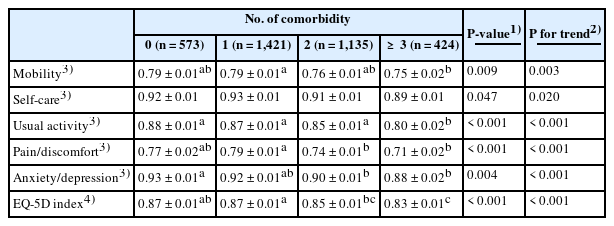
-
 Abstract
Abstract
 PDF
PDF - Objectives
This study aimed to explore the cross-sectional association between health-related quality of life (HRQoL) according to the number of comorbidities in older adults with type 2 diabetes mellitus (T2DM) using the Euro Quality of Life-5 Dimensions (EQ-5D) index. Methods: This study included 3,553 participants aged ≥ 65 years from the 2008–2020 Korea National Health and Nutrition Examination Survey. Dietary data were collected through 24-hour recall interviews by trained researchers, and demographic and lifestyle information via self-administered questionnaires. HRQoL was measured using a modified EQ-5D scale. Multivariable linear regression analyzed the associations between EQ-5D scores, nutrients and comorbidity, controlling for sociodemographic and health variables. Results: Most participants reported ‘no problems’ in the EQ-5D scores, although approximately 17% to 47% of participants reported ‘some problems’ or ‘extreme problems,’ depending on the dimension. As comorbidities increased, significant declines were observed across all dimensions, particularly in mobility, usual activities, pain/discomfort, and anxiety/ depression. Nutrient intake analysis revealed that participants with three or more comorbidities consumed less carbohydrates, but more fat. Conclusion: Our findings demonstrate that among older adults with T2DM, a higher number of comorbidities is associated with decreased HRQoL. Additionally, there are differences in nutrient intake patterns among those with more comorbidities, specifically decreased carbohydrate intake and increased fat intake. These results emphasize the need for comprehensive and tailored management strategies that consider both diabetes and the co-occurring health conditions. By addressing the complex healthcare needs of individuals with multiple comorbidities, it is possible to enhance their HRQoL and overall well-being.
- 1,667 View
- 28 Download

- [English]
- Sex differences in health-related quality of life among older Korean adults with type 2 diabetes mellitus: a cross-sectional study
- Hyeonji Jeong, Kyong Park
- Korean J Community Nutr 2024;29(4):336-347. Published online August 31, 2024
- DOI: https://doi.org/10.5720/kjcn.2024.00003
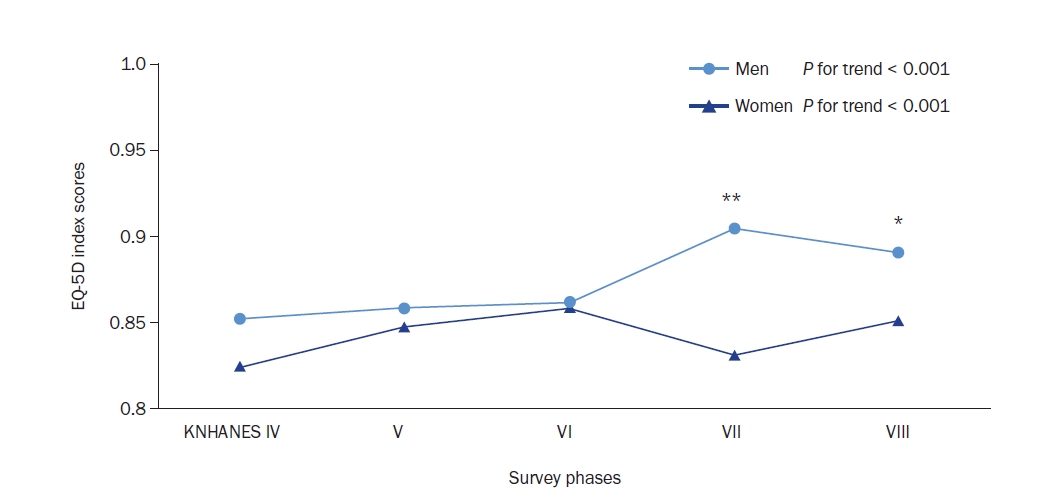
-
 Abstract
Abstract
 PDF
PDF - Objectives
This cross-sectional study examined sex differences in Health-Related Quality of Life (HRQoL) among seniors with Type 2 Diabetes Mellitus (T2DM).
Methods
Data from the Korea National Health and Nutrition Examination Survey (2008–2020) were analyzed. The EuroQol-5 Dimensions (EQ-5D), a measure of HRQoL, was used. It comprises five dimensions: mobility, self-care, usual activity, pain/discomfort, and anxiety/depression, each with three levels.
Results
Analysis of 3,826 older adults with T2DM showed a significant increasing trend in the EQ-5D Index from the 4th survey phase onwards (P for trend < 0.001 for both men and women). Men consistently reported higher EQ-5D levels than women across all survey years. Women’s EQ-5D levels remained lower than men’s, maintaining a decade-old disparity (P < 0.05). Men scored significantly higher (P < 0.05) in most EQ-5D domains, except for self-care and anxiety/depression, resulting in a higher total EQ-5D Index (P = 0.001). Increased comorbidities were strongly associated with lower EQ-5D levels in both sexes. Additionally, there was a negative correlation between the EQ-5D Index and refined grain intake for both sexes (P for trend < 0.001), with high-EQ-5D groups consuming fewer refined grains. Women in the high-EQ-5D group consumed more nuts, vegetables, and meat compared to men (P for trend < 0.05).
Conclusions
Our study highlights the sex disparities in HRQoL among older adults with T2DM. The findings suggest the need for tailored treatment guidelines aimed at improving the HRQoL of elderly T2DM patients, with a focus on their sex-specific characteristics. Implementing these tailored guidelines could enhance the HRQoL of older women with T2DM and promote more equitable healthcare outcomes. This underscores the importance of considering sex differences to comprehensively improve the well-being of this population. -
Citations
Citations to this article as recorded by- Understanding Gender Disparities in Quality of Life Among Patients With Type 2 Diabetes in Ethiopia: An Institutional‐Based Study
Enguday Demeke Gebeyaw, Girma Deshimo Lema
Lifestyle Medicine.2025;[Epub] CrossRef
- Understanding Gender Disparities in Quality of Life Among Patients With Type 2 Diabetes in Ethiopia: An Institutional‐Based Study
- 2,078 View
- 39 Download
- 1 Crossref

Original Articles
- [English]
- Needs for Development of IT-based Nutritional Management Program for Women with Gestational Diabetes Mellitus
- Chan Jung Han, Sun Young Lim, Eunsuk Oh, Yoon Hee Choi, Kun Ho Yoon, Jin Hee Lee
- Korean J Community Nutr 2017;22(3):207-217. Published online June 30, 2017
- DOI: https://doi.org/10.5720/kjcn.2017.22.3.207
-
 Abstract
Abstract
 PDF
PDF - OBJECTIVES
The aim of this study was to examine self-management status, nutritional knowledge, barrier factors in dietary management and needs of nutritional management program for women with Gestational Diabetes Mellitus (GDM).
METHODS
A total of 100 women with GDM were recruited from secondary and tertiary hospitals in Seoul. The questionnaire composed of general characteristics, status of self-management, dietary habits, nutrition knowledge, barrier factors in dietary management, needs for nutrition information contents and nutritional management programs. Data were collected by a self-administered questionnaire. All data were statistically analyzed using student's t-test and chi-square test using SAS 9.3.
RESULTS
About 35% of the subjects reported that they practiced medical nutrition and exercise therapy for GDM control. The main sources of nutrition information were ‘internet (50.0%)’ and ‘expert advice (45.0%)’. More than 70% of the subjects experienced nutrition education. The mean score of nutrition knowledge was 7.5 point out of 10, and only about half of the subjects were reported to be correctly aware of some questions such as ‘the cause of ketosis’, ‘the goal of nutrition management for GDM’, ‘the importance of sugar restriction on breakfast’. The major obstructive factors in dietary management were ‘eating more than planned when dining out’, ‘finding the appropriate menu when dining out’. The preferred nutrition information contents in developing management program were ‘nutritional information of food’, ‘recommended food by major nutrients’, ‘the relationship between blood glucose and food’, ‘tips on menu selection at eating out’. The subjects reported that they need management program such as ‘example of menu by calorie prescription’, ‘recommended weight gain guide’, ‘meal recording and dietary assessment’, ‘expert recommendation’, ‘sharing know-how’.
CONCLUSIONS
Based on the results of this study, it is necessary to develop a program that provide personalized information by identifying the individual characteristics of the subjects and expert feedback function through various information and nutrition information contents that can be used in real life. -
Citations
Citations to this article as recorded by- Chronically ailing or failing chronically: a typology of South African diners living with diabetes
Adam Viljoen, Martinette Kruger
International Journal of Spa and Wellness.2024; 7(2): 109. CrossRef - Machine Learning-Based Prediction of Abdominal Subcutaneous Fat Thickness During Pregnancy
Moon Sook Hwang, Eunjeong Song, Jeonghee Ahn, Seungmi Park
Metabolic Syndrome and Related Disorders.2023; 21(9): 479. CrossRef - Current Status and Effects of Nutrition Education Programs for Diabetic Patients in Korea
Hae Jin Kang
The Journal of Korean Diabetes.2018; 19(2): 106. CrossRef
- Chronically ailing or failing chronically: a typology of South African diners living with diabetes
- 943 View
- 2 Download
- 3 Crossref

- [English]
- Development and Effects' Analysis of Nutrition Education Program for Diabetes Mellitus at Community Health Center: Focused on Individual Daily Energy Requirements and Food Exchange Units
- Ji Yoon Oh, Sook Bae Kim
- Korean J Community Nutr 2010;15(4):485-497. Published online August 31, 2010
-
 Abstract
Abstract
 PDF
PDF - The purpose of this study was to investigate effects of the developed nutrition education program focused on individual daily energy requirements and food exchange units using Food Exchange System for diabetes mellitus at a community health center. Developed the nutrition education program, four weeks' nutrition education including provided twice individual meal as diet therapy (2 hour/lesson/week, 4 week), was provided to 20 diabetic elderly (12 male, 8 female, 50-75 yrs): 1st lesson "Introduction: management of diabetes mellitus", 2nd lesson "6 Food groups and sources of 6 food groups", 3rd lesson "Individual daily energy requirements and food exchange units", and 4th lesson "Food choice for diabetes mellitus". For effects' analysis of the developed program, we assessed the changes in anthropometric characteristics; biochemical characteristics and nutrient intakes using 24 hr recall method. Effects of the developed nutrition education program were as follows: weight was significantly decreased, blood urea nitrogen (BUN) and glycosylated hemoglobin (HbA1c) were significantly decreased, and distribution of subjects in BUN and HbA1c was significantly changed. In protein : fat : carbohydrate (PFC) ratio, it was significantly changed from 15.98 : 16.30 : 66.69 to 17.51 : 18.94 : 64.10. In evaluation of nutrient intakes by Dietary Reference Intakes for Koreans (KDRI), protein, fiber, fat, vitamin E, niacin, folic acid, calcium and zinc were shown significantly positive changes in distribution of subjects according to intake level. The index of nutrition quality (INQ), nutrition adequacy ratio (NAR) and mean nutrition adequacy ratio (MAR) were significantly increased. In conclusion, the developed 4 weeks' nutrition education program focused on individual daily energy requirements and food exchange units using Food Exchange System for diabetes mellitus at community health center may improve the symptom of diabetes mellitus.
- 221 View
- 1 Download

- [English]
- Evaluation of Nutrition Education for Diabetes Mellitus Management of Older Adults
- Hyun Joo Kang, Eun Mi Shin, Kyung Won Kim
- Korean J Community Nutr 2009;14(6):734-745. Published online December 31, 2009
-
 Abstract
Abstract
 PDF
PDF - Diabetes mellitus is the prevalent disease among older adults. The purpose of this study was to implement and evaluate the nutrition education program for diabetes mellitus patients aged 60 and over. The one group pretest and posttest design was employed to evaluate the program effectiveness. Nutrition education program for diabetes mellitus patients was carried out at the public healthy center in Guri city. The 38 out of 63 patients completed education program. They received four sessions of group education during four weeks. Nutrition education materials (booklet, leaflet) for older adults were provided to participants. Data about blood glucose, blood pressure, nutrition and diabetes mellitus knowledge, dietary behavior, dietary intake by 24-hour recalls were collected before and after nutrition education to evaluate the program effectiveness. All data were statistically analyzed using SAS package (ver.8.2) and significant difference was evaluated by chi-square-test, paired t-test and Wilcoxon signed rank test. Study results showed that blood pressure and blood glucose were slightly decreased after nutrition education but they did not reach statistical significance. There were positive changes in nutrition knowledge and dietary behavior. The total score of nutrition and diabetes knowledge increased significantly (p < 0.001), and the total score of dietary behavior was improved (p < 0.05) after nutrition education. Dietary intakes of most of nutrients examined were not significantly different between preand post-test. Based on study results, it appears that nutrition education program for the aged diabetes mellitus patients might effectively increase nutrition knowledge, dietary behavior and diet quality. This nutrition education program can be used at the public health centers or senior centers for the management of diabetes mellitus for older adults.
- 299 View
- 12 Download

- [English]
- Comparison of Nutritional Status and Inflammational Markers in DM and nonDM Hemodialysis Patients
- Suan Kim, Cheongmin Sohn, Dong Wan Chae
- Korean J Community Nutr 2005;10(5):693-699. Published online October 31, 2005
-
 Abstract
Abstract
 PDF
PDF - Protein-calorie malnutrition is common in maintenance dialysis patients. Indeed, diabetic patients with chronic renal failure are considered to be at increased risk of malnutrition. The aim of this study was to compare the nutritional status and markers of inflammation of hemodialysis patients with and without type 2 diabetes. We compared nutritional parameters and C-reactive protein (CRP) as a marker of inflammation in 30 type 2 diabetic patients and age-matched 30 non-diabetic patients with hemodialysis. Serum albumin was significantly lower in patients with type 2 diabetes (3.45 +/- 0.43 g/dL) than in non-diabetic patients (3.64 +/- 0.36 g/dL) (p < 0.05). In contrast, the concentration of serum CRP was significantly higher in type 2 diabetes (1.42 +/- 1.8 mg/dL) (p < 0.05). There were significant negative-relationships between serum albumin and CRP level in both diabetic (r = -0.553, p < 0.01) and non-diabetic (r = -0.579, p < 0.01) patients. In diabetic patients, serum albumin level was significantly correlated with hemoglobin (r = 0.488, p < 0.01) and hematocrit (r = 0.386, p < 0.01). Diabetic patients as compared to non-diabetic patients showed a significant (p < 0.01) increased serum triglyceride (TG) (153.1 +/- 80.1 mg/dL vs 101.6 +/- 62.4 mg/dL) and decreased serum HDL cholesterol (36.89 +/- 13.48mg/dL vs 47.00 +/- 14.02 mg/dL, P < 0.05). There were significant correlations in the intake of calorie and serum albumin levels in both diabetic (r = 0.438, p < 0.05) and non-diabetic (r = 0.527, p < 0.05) patients. Serum CRP level was negatively correlated with calorie (r = -0.468, p < 0.05), protein (r = -0.520, p < 0.01) and fat intakes (r = -0.403, p < 0.05) in diabetic patients and calorie (r = -0.534, p < 0.05) and protein intakes (r = -0.559, p < 0.05) in non-diabetic patients. The prevalence of protein malnutrition and the risk factors of cardiovascular disease were significantly higher in type 2 diabetic patients than in non-diabetic hemodialysis patients. Thus, we can suggest that the higher comorbidity and mortality rate in diabetic hemodialysis patients are partially explained by malnutrition and inflammation.
- 274 View
- 1 Download

- [English]
- A Study on the Sociopsychological Factors Influencing the Dietary Compliance of Diabetics by Using Focus Group Interview
- Sun Jung Choe, Hae Ryun Park, Dong Yean Park, Hong Seok Ahn
- Korean J Community Nutr 2000;5(1):23-35. Published online March 31, 2000
-
 Abstract
Abstract
 PDF
PDF - The purpose of this study was to find the sociopsychological factors influencing the compliance of dietary regimen in diabetes by using focus group interviews. The data were collected from fifty three diabetes patients in eleven focus groups from September 1997 to March, 1998 in Seoul and Suwon Korea. The interviews were tape-recorded and the contents of the interviews were analysed by researchers. The subjects knew the causes, complications, and therapies of diabetes although they were incorrect at times . Patients had a wide range of outcome expectations from very optimistic to pessimistic. They recognized diabetes as a disease which needs life-time care, and they though that good care could provide a normal life. One the other hand they thought diabetes could lead to death through complications, and cause financial problems as well as social isolation. As for self-efficacy they recognized the importance of compliance to diet regimen but they thought the diet therapy was very difficult and were not very willing to follow it. They felt medical professionals, especially doctors, were influential for the therapies. However they frequently felt counselling provided by doctors was insufficient in time and content and led to attitude problems. They felt support from families and others was often insufficient and inadequate. Nutrition education fostering outcome expectation, social support, and self-efficacy is needed to increased compliance. The most influential referents were medical professional including doctors, nurses, dieticians, so their role in diet therapy should by emphasized.
- 290 View
- 0 Download

- [English]
- Distribution and Prevalence Estimation of Cardiovascular Risk Factors through Community Based Health Examination Survey
- Soon Young Lee, Youngok Kim, Kun Sik Han, Hae Kyung Kim, Ju Won Park, Yeon Kyung Lee, Seung Soo Shin
- Korean J Community Nutr 1999;4(4):521-528. Published online December 31, 1999
-
 Abstract
Abstract
 PDF
PDF - Cardiovascular disease is very prevalent in Korea, and many risk factors, if properly identified are possibly corrected. However, the study results on prevalence and distribution of risk factors may not be reliable while the risk factors of disease are always issued on health promotion projects conducted recently in a community. The subjects of this study were 854 adults who participated in the health and nutrition survey in a community. They were aged between 20 and 69 and sampled representatively. This study intended to estimate the prevalence and the distribution of risk factors of cardiovascular disease such as hypertention, diabetes mellitus, hypercholesterolemia, and obesity. Systolic blood pressure and diastolic blood pressure levels were estimated at 123.9+/-2.2mgHg(men), 117.9+/-1.7mgHg(women), and 80.4+/-1.5mg(men), 74.9+/-1.1mgHg(women), respectively. Glucose level was estimated at 99.1+/-2.3mg/dl in men, and 95.7+/-1.7mg/dl in women. The estimated level of total cholesterol and HDL-cholesterol were 183.4+/-3.8mg/dl(men), 181.7+/-3.1mg/dl(men), and 122.0+/-4.5mg/dl (women), and body mass index was estimated at 24.0+/-0.4kg/m2 in men and 23.9+/-0.4kg/m2 in men and 23.9+/-0.3kg/m2 in women. The prevalence of hypertension was 20.5% for men, and 14.4% for women. The prevalence of diabetes mellitus was estimated to 6.9% for men, and 6.1% for women. The estimated prevalence of hypercholesterolemia was 3.8%(men), 3.9%(women). The rate of obesity was estimated to 28.5%(men), 28.4% (women), respectively. The levels of blood pressure, glucose, and cholesterol were higher in men than in women in almost all the almost ate groups. The prevalence of hypertension for men is about 20%. It was found that the prevalence of diabetes mellitus for males aged between 40 and 59 was rapidly increased. The risk factor with highest prevalence was obesity, and hypertension and diabetes mellitus were the second and third most prevalent.
- 260 View
- 0 Download


 KSCN
KSCN

 First
First Prev
Prev



